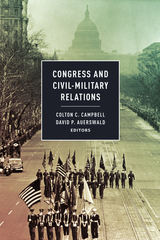
While the president is the commander in chief, the US Congress plays a critical and underappreciated role in civil-military relations—the relationship between the armed forces and the civilian leadership that commands it. This unique book edited by Colton C. Campbell and David P. Auerswald will help readers better understand the role of Congress in military affairs and national and international security policy. Contributors include the most experienced scholars in the field as well as practitioners and innovative new voices, all delving into the ways Congress attempts to direct the military.
This book explores four tools in particular that play a key role in congressional action: the selection of military officers, delegation of authority to the military, oversight of the military branches, and the establishment of incentives—both positive and negative—to encourage appropriate military behavior. The contributors explore the obstacles and pressures faced by legislators including the necessity of balancing national concerns and local interests, partisan and intraparty differences, budgetary constraints, the military's traditional resistance to change, and an ongoing lack of foreign policy consensus at the national level. Yet, despite the considerable barriers, Congress influences policy on everything from closing bases to drone warfare to acquisitions.
A groundbreaking study, Congress and Civil-Military Relations points the way forward in analyzing an overlooked yet fundamental government relationship.

Consider two polar images of the same medical condition: the pale and fragile Camille ensconced on a chaise in a Victorian parlor, daintily coughing a small spot of blood onto her white lace pillow, and a wretched poor man in a Bowery flophouse spreading a dread and deadly infection. Now Katherine Ott chronicles how in one century a romantic, ambiguous affliction of the spirit was transformed into a disease that threatened public health and civic order. She persuasively argues that there was no constant identity to the disease over time, no “core” tuberculosis.
What we understand today as pulmonary tuberculosis would have been largely unintelligible to a physician or patient in the late nineteenth century. Although medically the two terms described the same disease of the lungs, Ott shows that “tuberculosis” and “consumption” were diagnosed, defined, and treated distinctively by both lay and professional health workers. Ott traces the shift from the pre-industrial world of 1870, in which consumption was conceived of primarily as a middle-class malaise that conferred virtue, heightened spirituality, and gentility on the sufferer, to the post-industrial world of today, in which tuberculosis is viewed as a microscopic enemy, fought on an urban battleground and attacking primarily the outcast poor and AIDS patients.
Ott’s focus is the changing definition of the disease in different historical eras and environments. She explores its external trappings, from the symptoms doctors chose to notice (whether a pale complexion or a tubercle in a dish) to the significance of the economic and social circumstances of the patient. Emphasizing the material culture of disease—medical supplies, advertisements for faraway rest cures, outdoor sick porches, and invalid hammocks—Ott provides insight into people’s understanding of illness and how to combat it. Fevered Lives underscores the shifting meanings of consumption/tuberculosis in an extraordinarily readable cultural history.
READERS
Browse our collection.
PUBLISHERS
See BiblioVault's publisher services.
STUDENT SERVICES
Files for college accessibility offices.
UChicago Accessibility Resources
home | accessibility | search | about | contact us
BiblioVault ® 2001 - 2024
The University of Chicago Press









